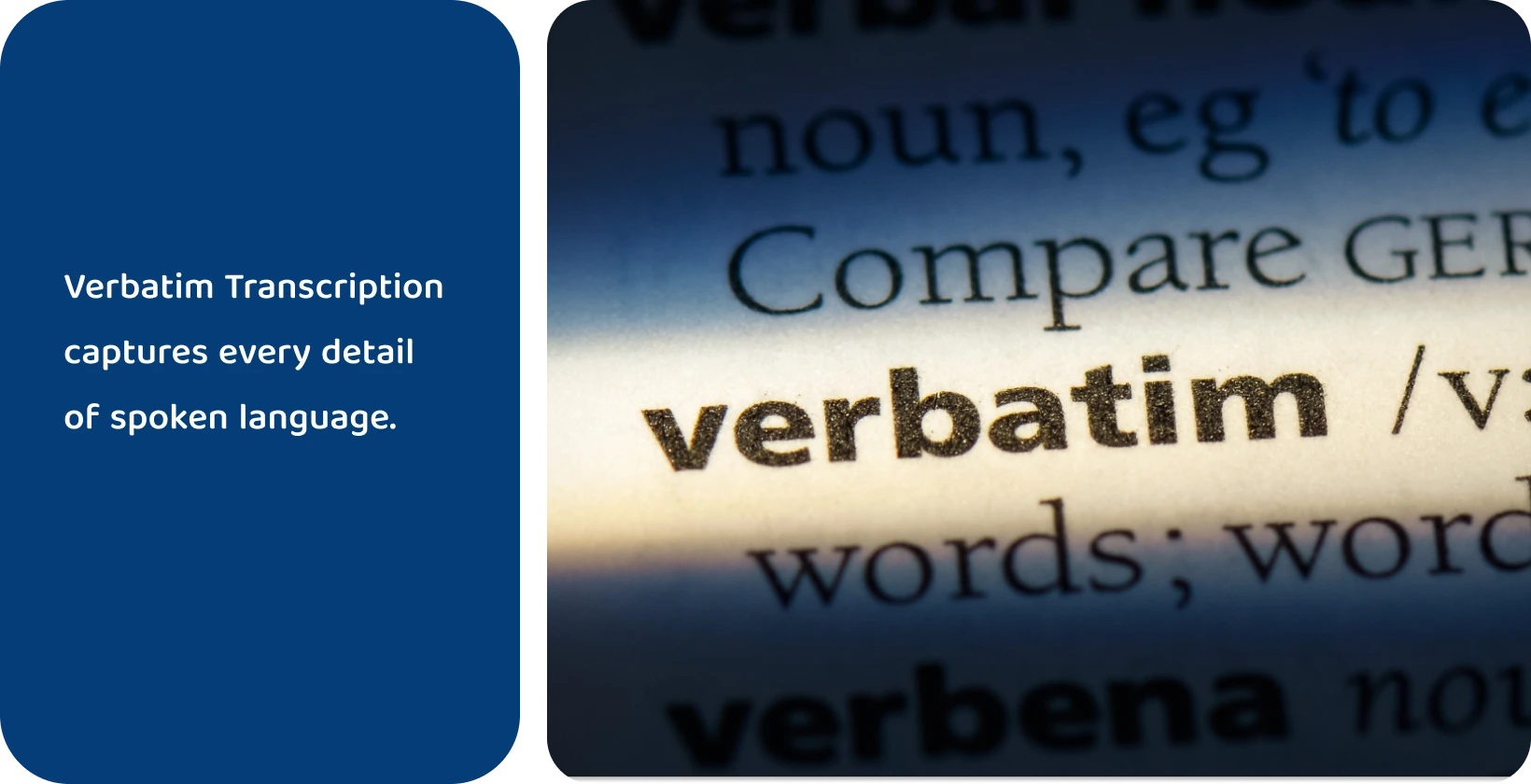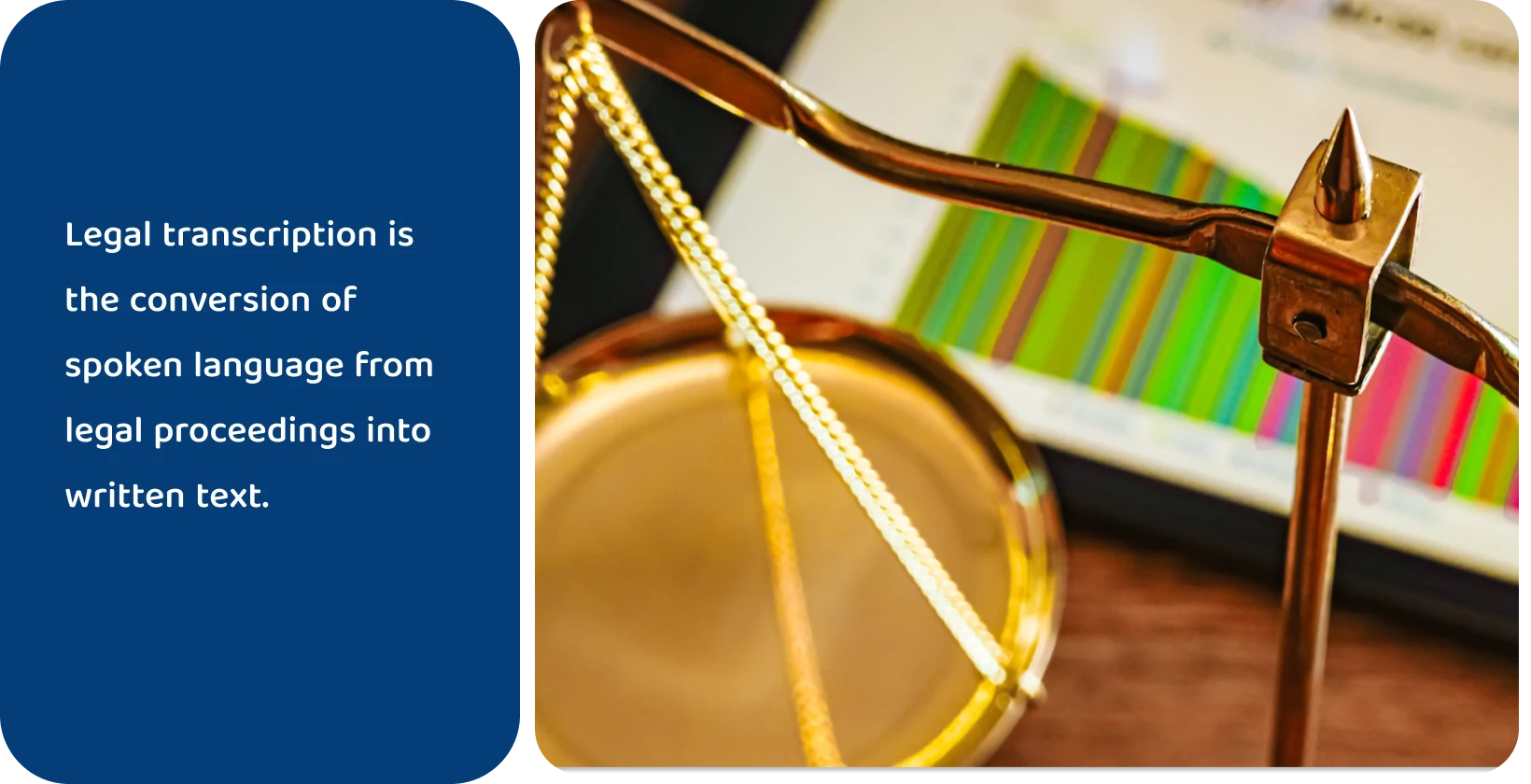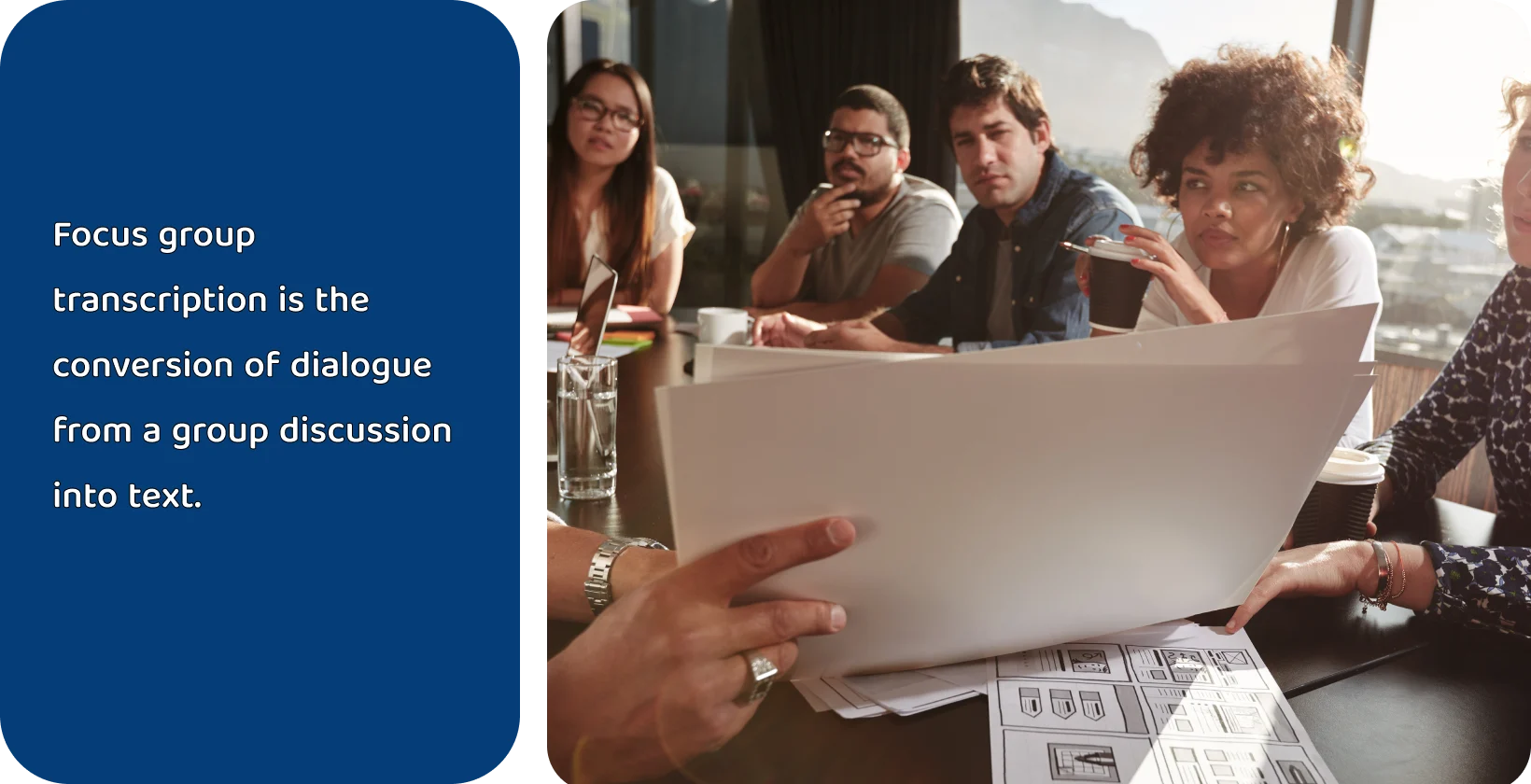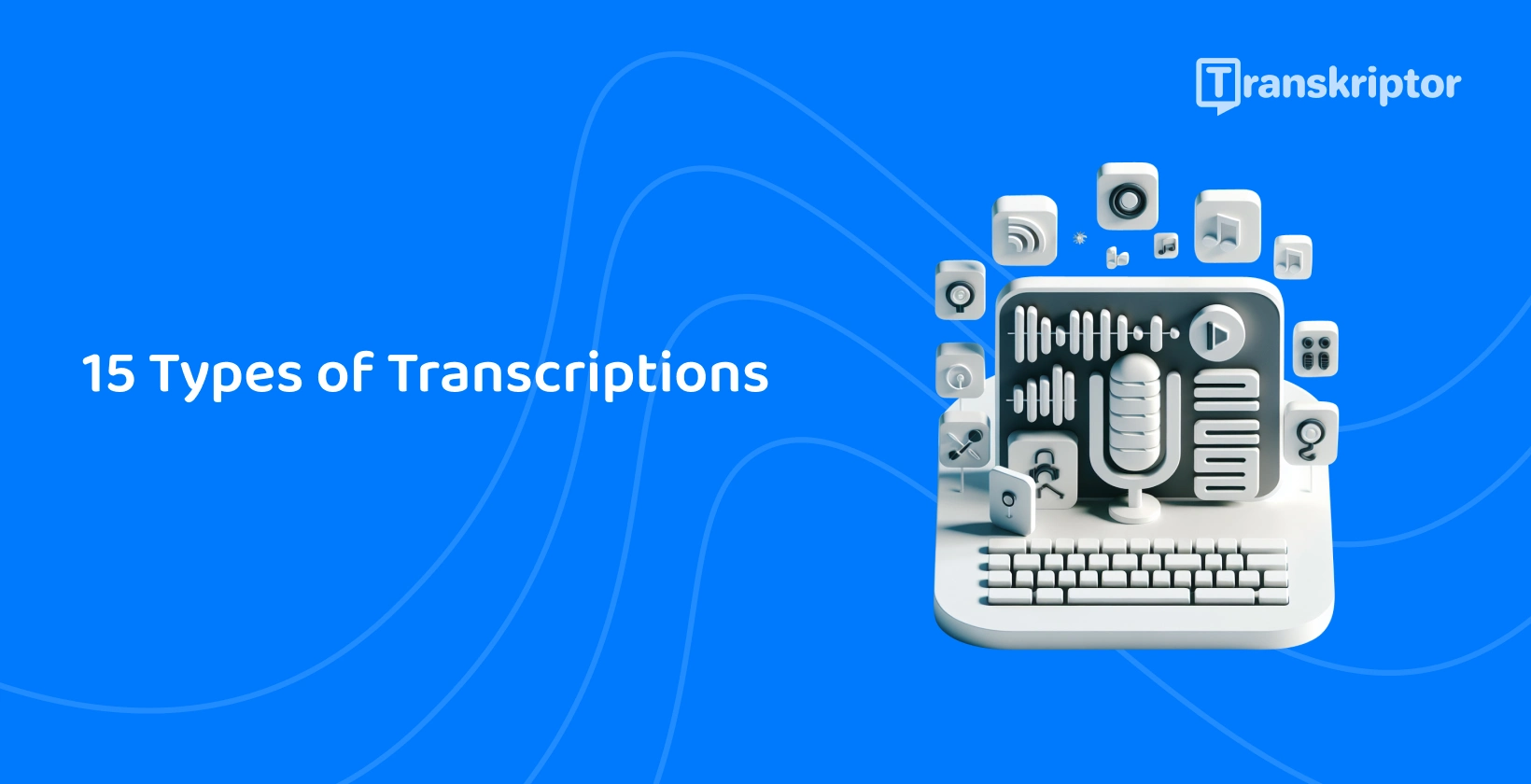Transcription offers numerous benefits, including making content more accessible. By converting audio and video files into written text, transcripts allow people with hearing impairments or language barriers to engage with the content. This inclusivity fosters equality and enables wider dissemination of information and ideas.
Accurate transcriptions facilitate seamless collaboration and knowledge sharing among professionals in healthcare. Legal transcriptions document court proceedings and interviews efficiently. Business transcriptions provide a valuable reference resource for meetings, interviews, and conferences.
The 15 types of transcriptions are listed below.
- Verbatim Transcription: Captures every detail of spoken language, ideal for legal proceedings and research requiring precise documentation.
- Clean Transcription: Edits out irrelevant speech elements, balancing readability with a fairly detailed representation of the original speech.
- Intelligent Transcription: Focuses on the essence of spoken conversations while omitting superfluous information, suitable for business and academic settings.
- Medical Transcription: Transcribes medical professionals' recordings into written documents, crucial for accurate patient record keeping.
- Legal Transcription: Converts legal proceedings into text, maintaining detail and accuracy essential for legal documentation and review.
- Academic Transcription: Transcribes educational content like lectures and seminars, enhancing accessibility and learning opportunities for students.
- Business Transcription: Converts business-related speech into text, facilitating improved communication and record-keeping within organizations.
- Focus Group Transcription: Transforms group discussion dialogue into text, aiding in comprehensive data analysis in market research.
- Language and Dialect Specific Transcription: Captures the nuances of specific languages or dialects, valuable for linguistic and cultural research.
- Real-Time Transcription: Offers immediate transcription of spoken words, enhancing accessibility for live events and broadcasts.
- Market Research Transcription: Converts market research data into written form, providing detailed insights for marketing analysis.
- Transcriptionist: A professional role specializing in converting spoken language to text, ensuring high accuracy and attention to detail.
- Edited Transcription: Refines raw transcripts for clarity and brevity, useful for media and education.
- Interview Transcription: Provides a detailed written record of interviews, preserving every word and pause for thorough analysis.
- Conference Transcription: Captures comprehensive dialogue from conferences, creating a detailed record for attendees and organizers.

1. Verbatim Transcription
Verbatim transcription refers to the process of converting spoken language into written form, capturing every utterance, pause, and filler word. Recognized for its meticulous detail, this transcription type shines in legal proceedings and research interviews. Its extensive detail leads to cluttered, hard-to-read documents.
Users commonly applaud verbatim transcription for its accuracy, though it is not suitable for every occasion. Ideal for situations requiring a precise record of language use, such as court hearings or detailed research. For instance, a lawyer requiring an exact written record of a witness's deposition would benefit immensely from verbatim transcription.
2. Clean Transcription
Clean transcription is an enhanced version of transcription. This transcription type is useful for its readability and comprehension, although it lacks the preciseness of verbatim transcription. Users respect its balance between accuracy and readability.
Clean transcription is beneficial for projects where clarity and conciseness matter more than capturing every utterance, such as corporate meetings or journalistic interviews. For example, a journalist looking to publish an interview may choose clean transcription to ensure the conversation flows well for their readers.
3. Intelligent Transcription
Intelligent transcription, like clean transcription, emphasizes the essence of a spoken conversation, while omitting redundant or irrelevant information. The main features of this transcription type include enhanced readability and focused content, offering a streamlined reading experience.
The primary downside of intelligent transcription is the potential loss of nuances that may be crucial in specific contexts. Transcribers typically appreciate intelligent transcription for its efficiency and readability, making it a popular choice for business conferences or seminars where capturing the main points is paramount. For instance, a conference organizer might opt for intelligent transcription to provide attendees with a concise summary of the key discussions.
4. Medical Transcription
Medical transcription involves transcribing medical professionals' voice recordings into written documents. Medical transcription is an essential process in healthcare documentation. This transcription type is preferable for its role in detail retention and maintaining patient records accurately.
Medical transcription may lack context if the transcriber is unfamiliar with medical jargon. Medical transcription is valuable in facilitating effective and efficient patient care.

5. Legal Transcription
Legal transcription is the conversion of spoken language from legal proceedings into written text. Known for its meticulous detail and accuracy, legal transcription has gained traction in the justice system. Primarily, this transcription type supports accurate record-keeping and helps legal professionals efficiently review case information.
Legal professionals appreciate legal transcription for its precision, despite the time investment. Recommended for law firms and courtrooms, legal transcription serves for transcribing court hearings, depositions, or legal briefs. For instance, a law firm might use legal transcription to accurately document a witness's deposition.
6. Academic Transcription
Academic transcription is the practice of transcribing educational content, such as lectures , interviews, and seminars, into written form. This type of transcription enhances accessibility and learning for students, especially those with hearing impairments.
While challenges such as language nuances may lead to potential misunderstandings, Transkriptor's advanced technology minimizes these risks, ensuring clear and accurate transcriptions. Users laud Transkriptor's academic transcription for its pivotal role in facilitating study, revision, and knowledge retention. For example, a university might leverage academic transcription to create written records of insightful guest lectures for future reference.
7. Business Transcription
Business transcription is a sought-after service that converts spoken language from business meetings, conferences, or interviews into written text. A potential downside is the occasional misinterpretation of industry-specific jargon.
Users are often satisfied with the improved workflow efficiency that business transcription brings. This transcription type is especially beneficial for corporations, small businesses, and entrepreneurs. An entrepreneur, for example, could use business transcription to document key takeaways from a brainstorming session, helping future decision-making processes.

7. Focus Group Transcription
Focus group transcription is the conversion of dialogue from a group discussion into text. This transcription type is praised for facilitating comprehensive data analysis, particularly in market research and sociological studies. Transcribing multiple voices potentially leads to confusion.
Users appreciate its role in tracking participant responses and gauging sentiment. It's particularly recommended for market researchers and sociologists. A market research firm might use focus group transcription to analyze consumer feedback on a new product.
8. Language and Dialect Specific Transcription
Language and dialect-specific transcription transforms spoken words from specific languages or dialects into written form. The main advantage of this transcription type is its excellent ability to capture regional nuances, thus preserving the original context and cultural color.
Users often laud the accuracy with which these transcriptions capture their vernacular. It's particularly useful for linguists, anthropologists, and cultural studies researchers. An anthropologist studying regional dialects could use this transcription service to accurately document and analyze spoken language variations.
9. Real Time Transcription
Real-time transcription, as the name suggests, is the immediate conversion of spoken words into written text. Valued for its immediacy, it enables users to consume information instantaneously, enhancing accessibility.
Users often commend its ability to provide an on-the-spot understanding of discussions. It champions accessibility, making it an ideal fit for live events and broadcasts. Thus, a news broadcasting company could use real-time transcription to provide accurate closed captions for a live news segment.
10. Market Research Transcription
Market research transcription is the conversion of market research audio or video data into written form. This transcription type is expert in data analysis, converting focus group discussions, interviews, and surveys into text. Its main advantage is the ability to capture verbatim responses, thereby ensuring accurate and detailed consumer insights.
The market research transcription process can be time-consuming due to the complexity of market research data. Users praise its efficacy in providing a wealth of actionable consumer insights.
12. Transcriptionist
Transcriptionist plays a crucial role in the transcription process, meticulously converting spoken language into written form. This role requires impeccable language skills and attention to detail. A key advantage of employing a transcriptionist is the guarantee of human precision, often surpassing automated services in terms of accuracy.
This service is particularly recommended for legal, medical, and academic fields, where accuracy is paramount. An instance could be a law firm hiring a transcriptionist to accurately transcribe court proceedings.
13. Edited Transcription
Edited transcription refines the raw transcript, omitting unnecessary details and refining the language for easy comprehension. The primary attribute of this transcription type is its focus on clarity and brevity, making it a popular choice for those seeking digestible content. Users appreciate its readability, although some may find the lack of detailed context a downside.
Edited transcription caters best to media professionals and educators, transforming verbose interviews or lectures into concise written content. Consider a journalist using edited transcription to present an interview succinctly and coherently to their readers.

14. Interview Transcription
Interview transcription accurately converts spoken dialogue from interviews into text format. The key feature is its verbatim nature, preserving every uttered word and pause. While this meticulous detail is a boon for qualitative researchers, it might prove excessive for general readers.
Users often praise its thoroughness, but caution about its lengthiness. Ideal for social science research and journalism, an example scenario could be a researcher transcribing interviews for in-depth analysis. Transkriptor will automatically transcribe your interview within minutes. When your order is done, you will receive an email informing that your text is ready.
15. Conference Transcription
Conference transcription is an invaluable tool for converting spoken content from conferences into written text. Its key feature is the comprehensive capture of the entire event's dialogue, offering a verbatim record of all spoken elements. Some users may find the detailed nature of conference transcriptions overwhelming while users commend its thoroughness for better comprehension.
Conference transcription type is beneficial for event organizers, participants, or those unable to attend, providing them with a detailed record. Picture an event manager using conference transcription to create a comprehensive archive of a significant industry summit.
What are the Advantages of Transcription?
The advantages of transcription are listed below.
- Enhanced Accessibility. Transcription allows individuals who are deaf or hard of hearing to access content that would otherwise be inaccessible. Transcription promotes inclusive communication and prevents information exclusion.
- Improved SEO and Indexing. Transcriptions make these contents searchable and indexable. This leads to better web visibility and increased organic traffic.
- Convenient Written Records. Transcriptions provide written documentation of spoken words, making it effortless to review, share, reference, and archive. This is particularly beneficial in legal proceedings, academic research, and corporate meetings where accurate record-keeping is crucial.
What are the Disadvantages of Transcription?
The disadvantages of transcription are listed below.
- Time-consuming. The process of manual transcription is quite lengthy, especially when dealing with large amounts of audio or video content, resulting in delayed delivery, particularly if it requires accurate and error-free transcriptions.
- Cost. High-quality transcription services or software are costly.
- Accuracy Concerns. Automated transcription software provides quick results, but it may struggle with accurately transcribing homonyms, accents, dialects, and poorly recorded audio. Human intervention is often necessary for correction.
What to Consider when Choosing Types of Transcription?
You should consider when choosing types of transcription the following.
- Purpose of Transcription: Understand the end-use of the transcription. A verbatim transcription might be required if it's for legal or medical purposes.
- Quality and Accuracy Needs: Determine the level of accuracy required. High-stakes settings like legal proceedings require extremely accurate transcriptions, whereas for other purposes, a general gist is sufficient. For example, Transkriptor converts speeches with up to 99% accuracy.
- Turnaround Time: Consider how quickly you need the transcription. Some services offer rapid turnaround but might compromise on accuracy or cost more. With Transkriptor, it takes approximately half the time of the audio file to convert it to text. For instance, your 10-minute-long audio file will be transcribed in only 5 minutes.
- Cost : Evaluate the budget. Automated transcription services are cheaper but less accurate. Professional transcription services are more expensive but provide higher accuracy and better handling of complex content.
- Confidentiality and Security: Ensure that the transcription service adheres to confidentiality and data security standards.
- Audio Quality: Poor audio quality significantly affects the accuracy of the transcription. High-quality recordings yield better results, especially with automated services.
How to Choose the Type of the Transcriptor that Would Yield the Most Benefit?
Choosing the most effective type of transcription largely depends on the specific needs. Assess the complexity, language, and demands of your project. It's essential to weigh the benefits of speed that come with automated transcription against the accuracy and attention to detail provided by manual transcription.
Consider Transkriptor for a speedy transcription service that doesn't compromise on accuracy, a cutting-edge automated solution that ensures your transcriptions are completed with remarkable precision in record time. The type of transcription chosen should align with the project's objective, whether it's for public viewing, legal usage, or research.
Transkriptor: A Comprehensive Transcription Solution
Transkriptor bridges the gap between the need for accurate transcriptions and the efficiency demanded by modern workflows. Whether you're working in legal, medical, academic, or any other field, Transkriptor provides a reliable, fast, and accurate transcription service that meets diverse needs, ensuring that content is more accessible and information is easily shared and analyzed. Try it now !


